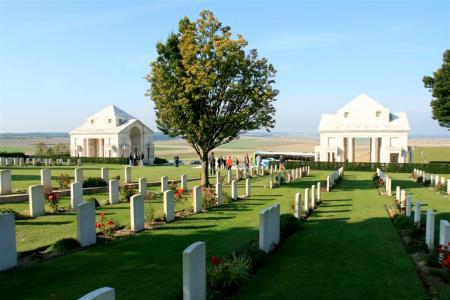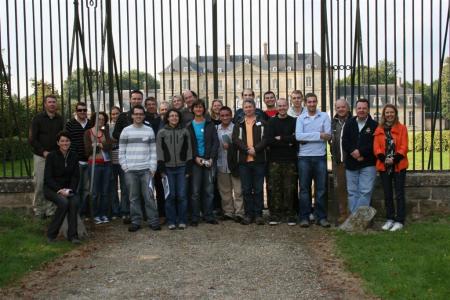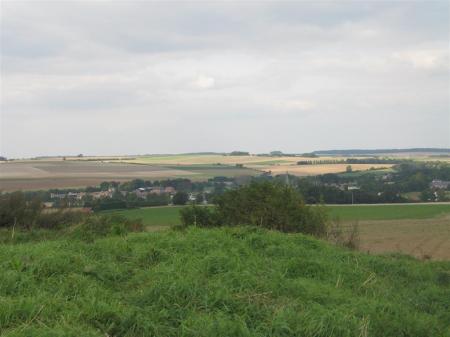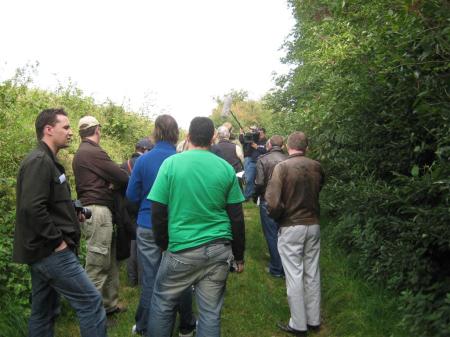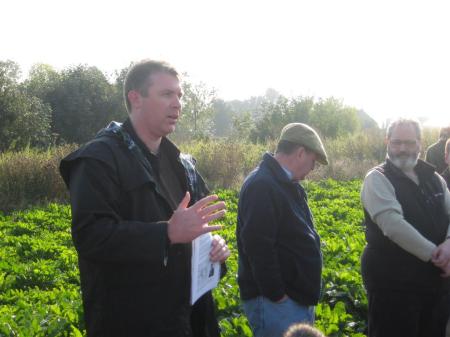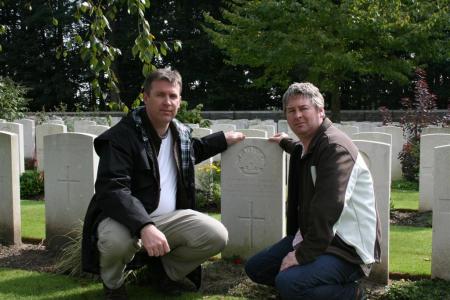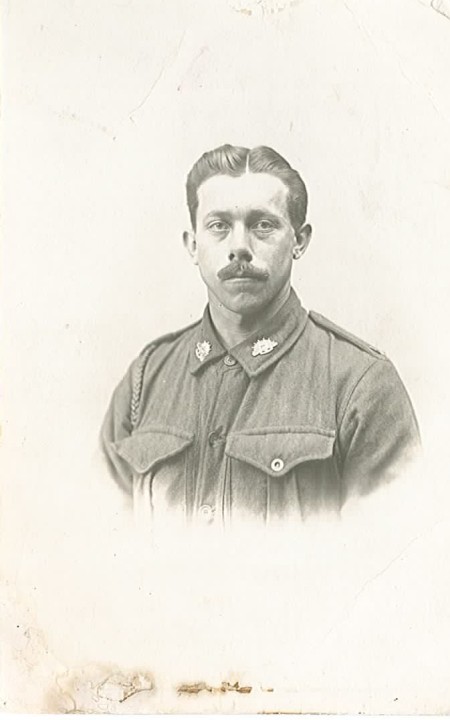William Henry Graham Parker grew up and worked as a farm labourer in the Cowra area of NSW, namely on the family property ‘Parkerville’. Aged 20, he enlisted in the AIF on 2 May 1916 at Cootamundra (No 2722); then went on to the Goulburn depot and into the 6th Reinforcements for the 56th Bn. After first going to England for further training in November 1916, Bill arrived in France on New Year’s Day 1917. Read the rest of this entry »
Soldier profile – Bill Parker
24 April, 2010Feast at Bussy
4 February, 2010Last week I happened to find a menu from a special dinner held by the 56th Battalion in France among the Souvenirs Collection at the Australian War Memorial’s Research Centre.
On the evening of 11 June 1918 the 56th’s CO, Lieutenant Colonel Cameron, hosted a dinner at the battalion officers’ mess at Bussy-les-Daours. Brigadier Stewart was the guest of honour and the COs of other units in the brigade also attended. The menu includes signatures of all the officers who attended, as well as a list of songs played by the 14th Brigade Band. The following includes my probably imperfect understanding of what the dishes were. I wonder what the other ranks had for dinner that night… Read the rest of this entry »
Lt John Charles Watt
21 October, 2009One of the more important figures in the 56th’s history was a remarkable and brave young man named John Charles Watt. Previously this post called for assistance in finding a photo of him and showed a blank silhouette of a man with a question mark on his face. Happily, thanks to the assistant of a couple of readers of this blog (see comments below), contact was soon made with the Watt family and the photo shown at left made available.
John was born on 28 September 1896 at Stewart’s Brook near Scone, NSW, son of John Howard Watt and Eliza Jane Watt. He later attended high school in Newcastle where he also completed four years of compulsory military service. At some stage the family (at least John Jr. and his mother) moved north to Emmaville, a tiny settlement in a tin mining area about 30 km north of Glen Innes. There John became a miner.
When war broke out in 1914, John was not quite 18, but it wasn’t long before he enlisted in the AIF in Sydney the following July. His father had recently died in Port Augusta, SA in March 1915. At the time he enlisted, John stood 5’ 10” tall, weighed 156 pounds (71 kg), and had brown eyes and dark hair. His religion was Church of England. He was initially allotted to the 10th Reinforcement of 4th Battalion and embarked for service overseas in October, joining his unit in Egypt on 21 January 1916. Almost straight away he began his rise through the ranks, making lance corporal on 2 February. Read the rest of this entry »
Soldier Profile – John Bermingham
4 September, 2009
John Bermingham, pre-war, 1900 (Courtesy Darren Bermingham)
Born in Young in 1879, John Bermingham grew up in the peaceful surroundings of country New South Wales. He soon showed a strong aptitude for working with machines, and eventually gained considerable expertise and employment in the field of mechanical engineering. With wife Sarah, daughters Annie and Edith, and sons Martin and Harry, the family settled in Narromine before the war.
Perhaps feeling that family duties outweighed those of King and Empire, John resisted the notion of joining up when war broke out in August 1914. Yet like so many others following the failure of the Gallipoli campaign and the resulting heavy losses, by early 1916 he had made his mind up to go and ‘do his bit’. Travelling to Cootamundra, the 36-year-old Bermingham enlisted in the AIF in March 1916 (No. 2128), and was allotted to the 4th Reinforcements for the 56th Battalion. By the end of April he was learning the routine and drill at the recruit training depot at Goulburn. The 4th Reinforcements, numbering around 150 men, left Sydney in early September aboard HMAT A15 Port Sydney. They arrived in the UK at the end of October and were immediately sent for a stint with the 14th Training Battalion at Hurdcott near Salisbury. Read the rest of this entry »
Project Update
19 August, 2009
Birthplace of the 56th: Tel el Kebir camp between Cairo and the Suez Canal in early 1916 (AWM photo C00207).
Sorry I’ve been a bit of a slack blogger – as you might have noticed I haven’t made a post since March. I guess I’ve just been devoting all my spare time to the book and have kept pushing the blog to a lower priority. Anyway, I thought I’d better provide a quick update on where we’re up to with the book. As I can see from the blog stats there are quite a number of people who check it out. I’m always happy to see and hear of the number of people interested in our project.
Over the past few months I’ve been concentrating on 1917 (a very eventful year) and have now finished writing the chapters on that whole year. The major battles were Louverval, Bullecourt, and the biggest was Polygon Wood. It literally took me months to properly research and write this, their biggest battle, in the sort of detail I wanted to. Since then I’ve moved into researching and writing about the first few months of 1918 and am now writing about the German spring offensive of March. Meanwhile, Nick has been beavering away on the earlier period; i.e. 1916 and the Egypt days. He is currently writing about Fromelles, the battalion’s first big battle. Read the rest of this entry »
Soldier profile – Mack Macdonald
19 March, 2009Mackenzie Macdonald was born in Carnoustie (near Dundee), in Forfarshire, Scotland. At some stage he migrated to Australia and by 1914 was working as a labourer on a property named ‘Runnymede’, near Stockinbingal, NSW. When war broke out, Mack as he was commonly known, enlisted on 29 August 1914 in Sydney. He was 28 years old, with a strongly built 5’ 9” tall, 13 stone frame.
An original member of 4th Battalion, he was a private in E Company and would likely have felt quite at home, given the high proportion of Scotsmen in that battalion. He was promoted Lance Corporal just prior to the Gallipoli landing, and to Corporal the day after, no doubt due to high losses. Mack’s luck held out and he survived, later taking part in the attack at Lone Pine in early August. During his time on the peninsula, his efforts did not go unnoticed; Read the rest of this entry »
Update – Nominal Roll
25 February, 2009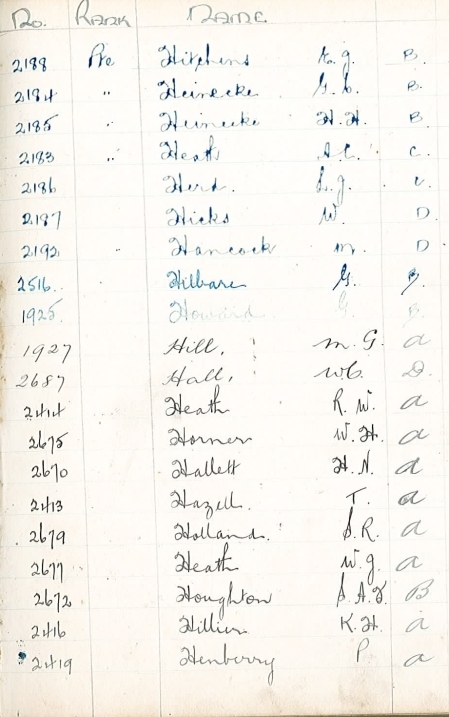
A page from the battalion's nominal roll book. Near the top it lists the Heinecke brothers, George and Herbert, both of whom were killed in 1917.
It’s been a while since my last post, but work is still progressing steadily with research and writing of the book. Alongside that, we’ve also continued to build the battalion’s nominal roll. We’re hoping to make it as complete as possible (within reason), by using a variety of sources.
These include source records held by the Australian War Memorial such as nominal rolls, embarkation rolls, the Roll of Honour and personal service records (held by National Archives). Of great help in crunching the numbers more efficiently has been assistance provided by Professor Peter Dennis and his AIF database (see Links), which brings the aforementioned sources together into one searchable database.
A lot of manual work has also gone into compiling this roll, including simply checking if names are on it when they are found in a variety of documents. We’re also lucky to have a battalion nominal roll book in the Memorial’s collection which covers most of the battalion’s existence from about mid 1916 through to late 1918 (see image above). I’ve actually employed my two teenage kids to go through copies of this roll and double check against what’s on our working roll (an Excel spreadsheet at this stage).
So far we’ve got almost 3,500 names and are confident that we’ve captured over 95% of the men who served in the battalion. We’re trying to include everyone, no matter how brief their stay in the battalion was, so it’s a lot of extra work. The men who joined the battalion late from another unit, and left it before the end of the war are the most difficult to find. There are bound to be a few of these types that fall through the cracks but with all the sources and cross-checking I’m confident we won’t miss many at all.
I reckon my eyes have now been over every single man’s name, to the point where if I see a name in a document, I can often say, “Oh yeah, I’ve seen him on the roll” and move on. I really need to get a life…
Visit to the battlefields
14 November, 2008A few weeks ago, Nick and I visited the Western Front battlefields and had the opportunity to see the places where the 56th had fought. We were part of a joint Australian War Memorial – Imperial War Museum tour; about ten Brits and a similar number of us Aussies. If you saw the 4 Corners program that aired on 10 November you would have seen our tour featured on that.
While Nick has been several times before, for me it was my first visit to the Western Front. It was truly wonderful to visit all the sites I’ve been studying and writing about for years. First we hit London for a couple of days, before taking the ferry over from Dover to Calais. It was a bit of a whirlwind tour, but boy did we ever pack a lot into those five days. We were on the go from first thing in the morning until after dark every day. We were so keen to see all these places and just explore as much as possible, that weariness was forgotten – that really hit hard after it was all over. We were also blessed with great weather and great company as the Brits were a good bunch. We had many fun times discussing the battles over a pint or two…
Day one: Doullens, Bertangles (where Monash had his HQ and was knighted by the King in 1918), Corbie, Heilly, saw the Morlancourt Ridge, then back to Amiens where we were based in a hotel where Australian officers had billeted in 1918.
Day two: Adelaide Cemetery, Villers-Brettoneux, le Hamel, Peronne, Mont St Quentin, Riqueval, Bellicourt, Estrees and Montbrehain.
Day three: Serre, the Sunken Lane (Lancashire Fusiliers), Hawthorn Redoubt, Montauban, Trones Wood, Mametz, Fricourt, Albert, Lochnagar Crater, Ulster Memorial, Beaumont Hamel, Y Ravine, High Wood and Delville Wood, Martinpuich, Flers and then Pozieres, (drove past Mouquet Farm) and finished up at Thiepval.
Day four: Louverval (where I gave a talk on the 56th Bn), Noreuil, Bullecourt, Vimy Ridge, Fromelles (where we visited the site of the recently discovered bodies), then up to Ypres in the evening, just in time for the Last Post at Menin Gate. Whew…
Day five: Ypres, Langemarck, St Julien (where Nick did his talk), Polygon Wood (where Lt Col Scott of the 56th is buried), Tyne Cot, Messines then back down into Ypres to visit the In Flanders Fields Museum.
After the tour wound up in Ypres, we travelled back across the Channel on the ferry to the UK again. I then stayed in London for another five days visiting musuems etc, and The National Archives at Kew.
While in France and Belgium we naturally visited most of the main Australian memorials and cemeteries where we were able to contemplate the scale of the losses, remember the diggers and pay our respects. I also got a lot out of visiting these sites from the point of view of writing about the battles; i.e. to walk the ground, see the lay of the land, gauge heights and distances etc. When I write about these places and battles now, I do so with much greater insight and greater confidence.
Soldier profile – Pte Leopold Meek
11 November, 2008Leopold William Meek was born in Palmerston North, New Zealand on 23 June 1893. At some stage he and his family moved to Sydney, New South Wales, where in September 1912 he signed on with the Royal Australian Navy for seven years. During part of this time he served on HMAS Australia. Gaining a discharge in mid 1914, he apparently became a carpenter; something he’d probably had experience with during his time in the navy, as his service card records an injury from a circular saw. In 1914, now 22 years old, he was residing in East Zetland, Sydney. Upon the outbreak of war in August 1914, he immediately joined the Australian Naval and Military Expeditionary Force, and took part in the seizure and occupation of German New Guinea between September and January 1915. Read the rest of this entry »
Harold Williams and the Gallant Company
5 September, 2008
In writing a history of the 56th Battalion, we feel blessed that at least one its members published his story, providing us with much valuable information and insights not found in the official papers. Lieutenant Harold Williams is our saviour in this respect, as he produced two books in fact; The Gallant Company (1933) and Comrades of the Great Adventure (1935). Both are well-written works being very informative and descriptive (particularly of people and landscapes), and not at all dull to read. Early reviews of the books seemed very good. 5th Division commander, Lt. Gen. Sir John Joseph Talbot Hobbs in writing the foreword called it ‘the best soldier’s story I have yet read in Australia.’
From the two books we have learned quite a bit about Williams himself, but not enough. We would very much like to find any of his descendants to learn more. We know basically what he looked like, yet have no photo of him. We know some of his thoughts through his books, but nothing more; nothing about his life after the war for example. We know he kept letters and a diary, so what became of them? Surely they must have survived. At the beginning of The Gallant Company, Williams noted: Read the rest of this entry »




